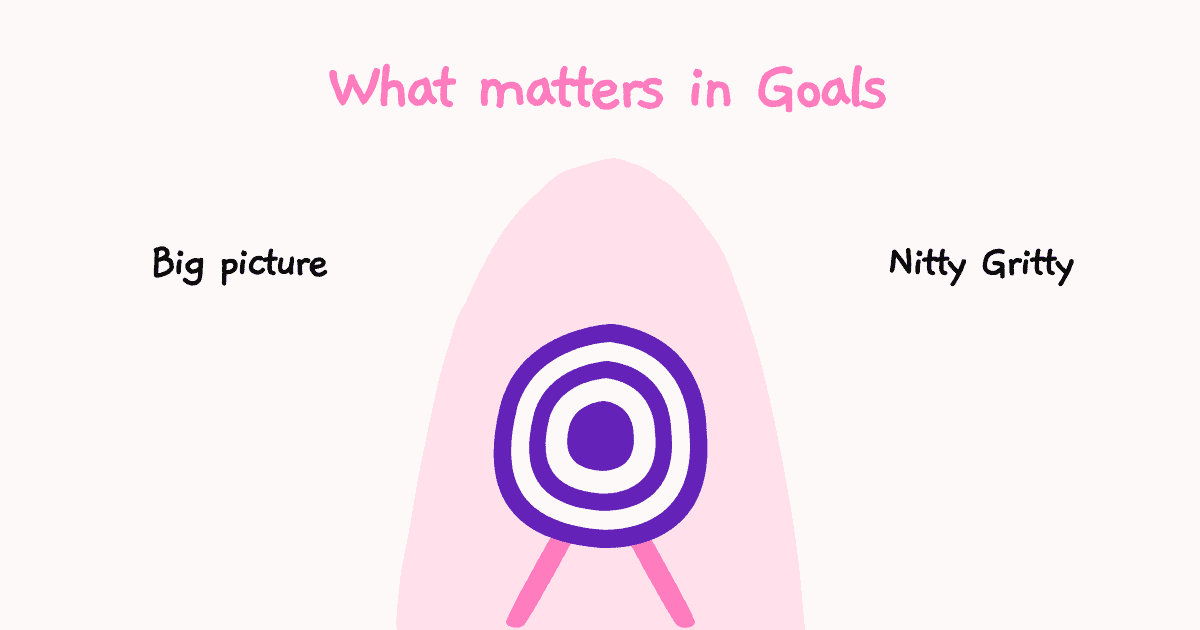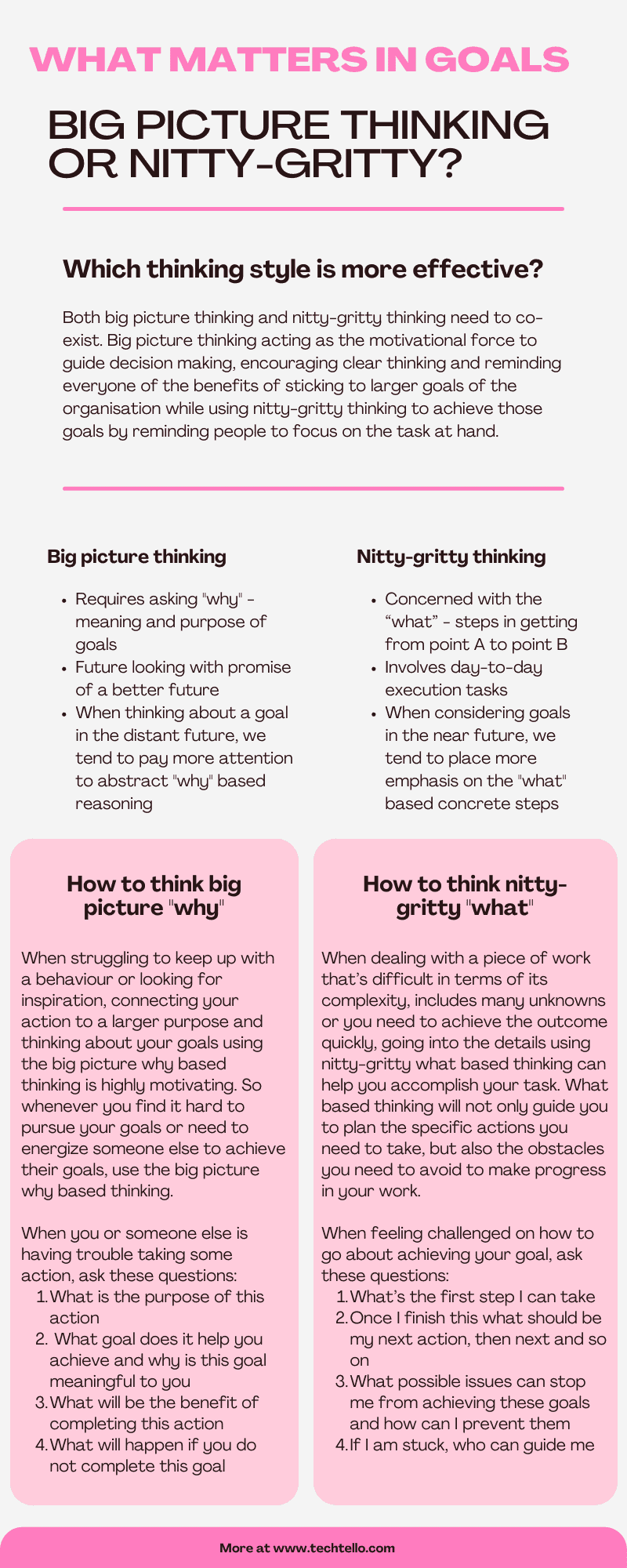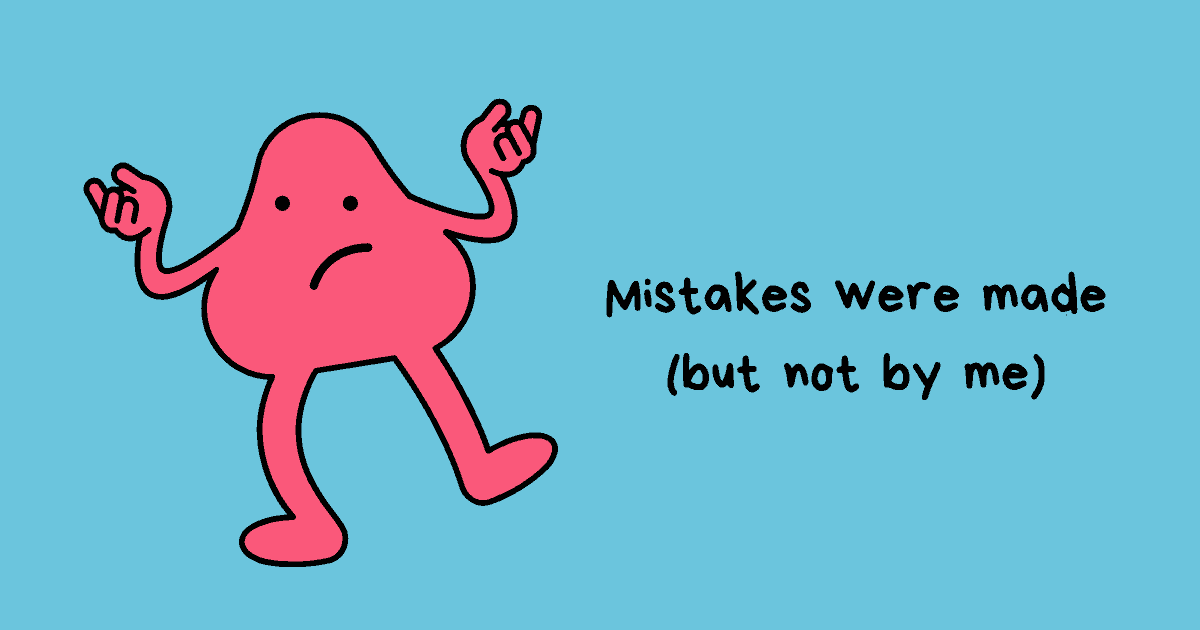What Matters In Goals: Big Picture Thinking or The Nitty-Gritty?

In most organisations, big picture thinking comes off as a seasonal flavour often appearing every few months. Mental gymnastics that goes with determining the “why” – meaning or purpose of goals, promise of a better future, and the excitement of doing something new definitely gets the creative juices flowing. Though not for all, most people in the organisation find this phase highly energising and exhilarating. But does this motivation last long?
The big picture thinking soon goes out of the picture being replaced by its nitty-gritty sister who’s only concerned with the “what” – the actual mechanics of getting from point A to point B; steps in the process. With the hostile takeover of the nitty-gritty thinking that’s only concerned with the “what”, the memory of big picture thinking with its “why” soon fades away. What happens then?
Once people get too involved in the day-to-day execution tasks, it’s often easy to not see the forest for the trees. With too much focus on details, people lose sight of the big picture – why they were doing something in the first place and signed up to be a part of this journey. Results?
Employees start protecting their team goals with my team vs your team attitude instead of dealing with conflicting priorities by connecting their decision to the big picture. More and more time is spent in arguing over minor issues that won’t generate any meaningful results. Time and energy is spent on inconsequential tasks without questioning their effectiveness. Out comes the product that’s not even close to what was envisioned in the beginning and what happens afterwards – excuses and blame games in the form of communication lapses and collaboration mishaps.
It is not uncommon to see these issues crippling the organisation on a daily basis and yet what do most people do. Spend more and more time in fixing the “what”, while it’s the “why” that can save the day. The reverse also plays out as we will see later.
Amazing Goal Planner
Become your best self by setting and achieving goals in all important areas of your life.
Which thinking style is more effective – big picture or the nitty-gritty?
The idea is not to choose one thinking style over the other, but for both to coexist. Big picture thinking acting as the motivational force to guide decision making, encouraging clear thinking and reminding everyone of the benefits of sticking to larger goals of the organisation while using nitty-gritty thinking to achieve those goals by reminding people to focus on the task at hand.
Both modes of thinking have their advantages and the best strategy is to shift the thinking style based on what you want to achieve and the specific challenges you are facing.
Look at it this way – if an employee is doing a mediocre job or finding it hard to draw inspiration in their day-to-day tasks, telling them why their performance matters to the company by connecting it to the larger meaning or purpose using the big picture thinking is often more inspiring than telling them what they need to do. In other words, describing what they should do may not bring about any change, while describing why they should do it just might. Take your own example – if your boss asks you to stay back late and assigns you a bunch of tasks with what needs to be done without explaining why, would you like to stay put and work hard?
“Thinking more abstractly about behavior can be very energizing because you are linking one particular, often small action to a greater meaning or purpose. Something that may not seem important or valuable on its own can be cast in a whole new light,” says Heidi Grant, a social psychologist in Succeed. She adds “The why of what you do is incredibly motivating, so it’s not surprising that many of us often prefer to think of our own actions in those terms. And if you want to motivate someone else to do something, describing it in why terms will also help persuade them to give it a try.”
Now, let’s look at it from the other angle. If your employee is struggling with a piece of work either because it’s highly complicated or unfamiliar to them, will constantly reminding them of its importance using the big picture thinking help in any way? Actually, it might irritate them more since you are not being helpful to them in any specific way. Rather it can be stressful to think about the big picture while already dealing with the anxiety of multiple unknowns with their current task. What they really need is a good dose of nitty-gritty thinking – breaking down their work into specific steps that need to be taken, determining what should be their first action, helping them work out how to collect data from that action to guide their next action and so on. This time the devil is in the details and no amount of inspiration can actually get the work done.
When you are trying to achieve your own goals and hit a roadblock, no amount of abstract big picture thinking can help you. What you need are the concrete steps to move forward. Same applies to building a new skill. Thinking about the why may be helpful in promoting your goal and getting you energized, but for something that takes a lot of time to learn, you need a plan – tactics to get there. Without “what” based thinking guiding your daily actions, motivation from the “why” won’t really get you anywhere.
In one study, undergraduates were asked to complete a short survey and return it within three weeks in order to earn a cash prize. Before receiving the survey, each participant completed a task designed to put them in either a why thinking or what thinking mindset. To encourage why thinking, the students were asked to take a list of ten activities like “opening a bank account” or “writing in a diary” and come up with reasons why someone might do these things. To create a what mindset, students were given the same list and asked to describe how they would actually go about doing each activity. The researchers then recorded how long it took for the students to achieve their goal by completing the survey and sending it back. The ones who had been encouraged to think “what” sent in their surveys nearly ten days earlier on average than those who thought “why.” Conclusion? Thinking about your goal with a what mindset guides you to focus on the specific action you need to take, which helps you to act more quickly in achieving your goal.
So, if you ask me which thinking style is better – big picture or the nitty-gritty, I will say it depends on your specific goal and the challenges you are facing at that moment.
Daily Weekly Monthly Planner Worksheets
Manage your to-do list, stay productive and cultivate healthy life habits with these planners.
How time impacts big picture and nitty-gritty thinking
So while a large number of biases rule our lives and impact our daily decision process, one that significantly impacts our goals is the factor of time. As explained in this research, when thinking about a goal in the distant future, you tend to pay more attention to abstract why based reasoning – how adopting this goal or doing this activity will be beneficial in the future. Psychologists like to call this desirability information – whether or not taking that action or achieving that goal will result in good things for you, what will you gain, how rewarding will be the experience.
Think of it this way. When your boss asks you to take up a new assignment starting next month, you tend to think “will this be good for my career.” When thinking about attending a conference three months from now, you evaluate “will this conference help me grow my network and build more connections.” When signing up for an online course that’s due to start in a few months, you consider “will this course help me build new skills”. You forget about the feasibility of all these goals and the specific actions you will need to take to put these goals into action. “What” takes a backseat till it’s time to implement. And then as you try to squeeze in too many things in your schedule, you are often left wondering “How did I end up adopting so many goals or signed up for all these activities. What was I really thinking?”
You not only end up adopting goals that add no meaning to your life, you also take on goals that are sometimes not feasible. Sitting at your friend’s charity function on a Saturday, you wonder how exactly you are going to travel to a client site next week while also planning your son’s birthday party, attending your daughter’s preschool graduation ceremony, delivering a major project due the same week and a bazillion other things you signed up for.
“Why” big picture thinking without the “what” nitty-gritty details makes you consider each activity in isolation and the time you would need to spend on it without recognizing the necessary trade-offs you need to make to keep your goals realistic.
Reverse also plays out well in life. When considering goals in the near future, you tend to place more emphasis on the what – the concrete steps you need to take to make it happen. This helps you in evaluating the feasibility of the goal and the specific actions you need to take to make it work.
Sitting on a Monday morning, if your boss asks you for a very complex report by the end of this week, you immediately think about everything you need to do to get the report ready in time. When an urgent client meeting pops up two days from now for the same afternoon when you also have your daughter’s basketball game in the morning, you plan out the whole thing in your mind – what time you will reach for the game and when you will need to leave to make it in time for your client meeting.
Relying only on nitty-gritty what based thinking for goals in the near future can also lead to a mistake. You may turn down a goal only because it may seem too much of a hassle at the moment. Without using the big picture why based thinking to guide you in those moments, you may give up on goals that might be highly rewarding in the future.
Heidi Grant beautifully sums this up in Succeed “When we think about what we want to do in the distant future, we sacrifice practical considerations for the potential for reward. And when we think about what we’ll do in the near future, we tend to be all business, no pleasure. Put differently, about the future, we think like explorers—but when it comes to the here and now, we’re more like accountants.”
How to think big picture “why”
When struggling to keep up with a behaviour or looking for inspiration, connecting your action to a larger purpose and thinking about your goals using the big picture why based thinking is highly motivating. So whenever you find it hard to pursue your goals or need to energize someone else to achieve their goals, use the big picture why based thinking.
When you or someone else is having trouble taking some action, ask these questions:
- What is the purpose of this action
- What goal does it help you achieve and why is this goal meaningful to you
- What will be the benefit of completing this action
- What will happen if you do not complete this goal
Mind Map Templates
Work through complex problems, identify correlations, and see the big picture using these mind map worksheets.
How to think nitty-gritty “what”
When dealing with a piece of work that’s difficult in terms of its complexity, includes many unknowns or you need to achieve the outcome quickly, going into the details using nitty-gritty what based thinking can help you accomplish your task. What based thinking will not only guide you to plan the specific actions you need to take, but also the obstacles you need to avoid to make progress in your work.
When feeling challenged on how to go about achieving your goal, ask these questions:
- What’s the first step I can take
- Once I finish this what should be my next action, then next and so on
- What possible issues can stop me from achieving these goals and how can I prevent them
- If I am stuck, who can guide me
Implementation Intentions Worksheet
Develop an action plan to avoid distractions, stay on track and achieve your goals with this template.
Summary:
Greater achievement comes from realizing how our thinking impacts our goals. By adopting the right mindset and using the right mode of thinking, we can overcome the challenges that stand in the way of achieving our goals. Use the big picture “why” based thinking when you need motivation and nitty-gritty “what” based thinking when dealing with a difficult task.
Make space for both and surface them out depending on the specific challenges you are facing.






























